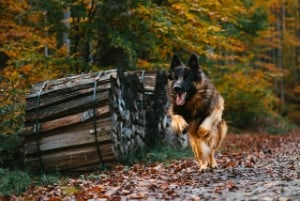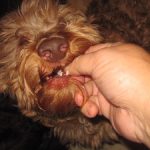
It has been reported that nearly 200 species of animals worldwide, 87 of which are birds, are threatened by feral and free-ranging dogs. According to BBC, it seems like these groups of canines are becoming a threat to wildlife. But what about pet dogs or those that are actually taken care of in a home?
I can still remember that one time when I was a little kid. Our dog brought home a dead chicken. Whether or not he was the culprit, I wasn’t sure. But our pet did not show any remorse whatsoever. In fact, he seemed happy, and that was shocking! To cut the story short, my grandfather put him on a leash with the fear that he would do it again.
Sounds familiar? Such a behavior is quite concerning and I am sure you are worried that your cuddly family member is already showing signs of a “prey drive”.
Here are things that you should watch out for:
1. Stares down a potential prey
The first manifestation of prey drive is when dogs stare down a potential prey, such as a squirrel, rabbit, chicken, bird, cat, or any live animal that is usually smaller than them, one that they can easily overpower. You could be on a dog walk and you notice that your pet seems uneasy or busy looking for something. Or, he could be “eye-stalking” a smaller dog or even an insect. That long and curious stare alone, even if your dog doesn’t do anything that could hurt the potential prey yet, is already a sign that your pet most likely has a predator drive.
There is a general sequence for predatory behavior and staring down at a potential prey or eye stalking is the very first one.
2. Stalks on something
Now this one here is when dogs take their prey drive to the next level. It is more than staring down. This time, they actually go and stalk their target. They use just about every sense that they possess to track down their target, whatever it is. Keep in mind that canines, just like human beings, have good memory, too. They could be like a detective looking for every lead that they could find so they can get into a potential prey.
Aside from their vision, dogs are known to have an excellent sense of smell or olfaction. And at this stage of the “hunt”, it’s their biggest asset to finally feed their desire for a prey sooner or later. So if you see your pet sniffing at the path that a cat has just been, that right there should already raise a flag. You would know that he is stalking.
3. Fetches smaller animals
While it is true that almost all dogs, if not all, have that natural instinct to “fetch” or retrieve certain items and give them back to their human owners, chasing after smaller animals and bringing them to you either dead or injured is a different story. More so if they show eagerness or excitement when they do this.
Fetching makes dogs feel good and that is something that they are naturally good at. This feature has been ingrained to them thousands of years ago when they were taught to help hunt and look for food. It’s in inherited skill that can further be passed on to the next generation.
Now if your pet has at some point brought home a dead squirrel or perhaps a rabbit, that’s a sign that he is becoming a predator. Since it is a doggy instinct to fetch, it could be very hard to stop, but there are things that you can do to control it. Feed their appetite for this activity by allowing them to play fetch using balls or Frisbee.
4. Chases anything that moves
Most dogs love to run, and this could be really fun, particularly if you are up for a game. This is another skill that they have inherited from their ancestors. But if this goes beyond chasing tennis balls or any toy, and your dog shifted to running after cats and small animals, skateboards, cars, bikes, and virtually anything that moves, that is a clear sign of an increased prey drive.
Prey chase drive is an overwhelming desire to go after things that have movements. In “mild” cases, it could be really annoying. But if it is too “high”, that’s when the drive becomes dangerous.
So what can you do? Contain them in a safe and secure place, particularly when you are not home. You can also try to do the behavioral work.
5. Bites a prey
Those seemingly playful bites that your pet dog does with his playmates may look harmless to you. But in some instances, that could be a sign of a prey drive already. In fact, when a dog starts to bite in such a way that he harms a person, another dog, or a different type of animal, that’s a predatory behavior in action. This could also be a part of “fetching”.
Like what we have said earlier, a dog may fetch a small animal either injured or dead. Even if you think that it’s only a “grab-bite”, you should never underestimate your dog’s ability to make that activity worse. Some dogs chase their targets without the intention of hurting them. If their prey drive gets extremely high, though, sooner or later, the next sign that you will see is a dead animal at your yard, doorstep, or even inside your home.
6. Kills the ‘catch’
Have you seen a dead squirrel or bird in your yard lately? That might not have been an accident. Your dog could actually be the culprit. A very strong prey drive could be dangerous, and one of the worst things that your dog could do is to kill his prey. This made me realize what I have witnessed that one time when our pet brought home the dead chicken. And it was a good thing that my grandpa had put him on a leash. Otherwise, there is no doubt that it would have happened again.
Although killing a “catch” may also be related to aggression, it could be one of the telltale signs of an increased prey drive in dogs as well.
7. Ignores your commands
While it is true that some dogs are stubborn by nature, ignoring your commands or not coming when you call them because they are too focused on eyeing or chasing their prey is another sign that they are acting a little too much on their prey drive. This should serve as a warning that your pet is starting to get way out of hand. With this, it is crucial that you do something about it. Behavioral work can help. You might have to resort to restraining them so that you can prevent them from engaging in more dangerous behaviors or activities.
8. Gets aroused by certain sounds
Believe it or not, but some dogs get excited when they hear certain sounds. It could be the sound of a small dog yelping, a squirrel running around the attic, a rabbit thumping, or even a sound of distress. This triggers their prey drive.
Try to observe your dog. He could be lying down quietly but would suddenly stand up and run when he hears something. This right here is another thing that you should watch out for.
9. Exhibits restlessness
Restlessness in dogs could mean many things. But it could also be a sign of a prey drive. Imagine yourself unable to do what you want to do. Sometimes you become restless, right? You pace around, tap your shoes, or may even talk rapidly. Dogs could be the same way. If they are unable to feed their prey drive, they could be restless as well.
If you have observed any of the above-mentioned signs in your dog, and he seems uneasy inside your home or perhaps on a leash, that would tell you that something is off.
Closing thoughts
Prey drive is not always a dangerous thing. But it could also drift to aggression and result in something really bad. Dogs with heightened prey drive could not only be a nuisance but could also be harmful even to human beings, especially with little kids. Observe your dog and if you see any sign of a prey drive, take precautionary steps.
Photo Credits
²
³
⁴
⁵
⁶
⁷
⁸
⁹





